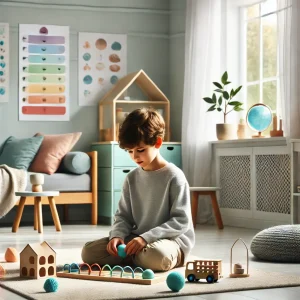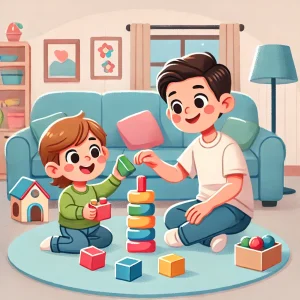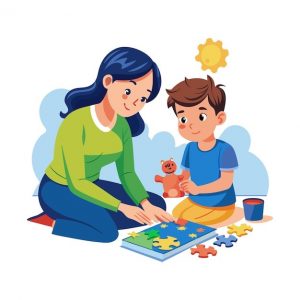Understanding Autism: The Colours to Avoid for a Harmonious Environment
By Rajini D
Last Updated: January 11, 2024
Welcome to our exploration of a unique and significant aspect of autism – its connection with colors. Have you ever wondered how the colors around us influence our emotions and behaviors? This is especially relevant when considering autism, a condition that affects how individuals perceive and interact with the world.
For individuals with autism, colors aren’t just hues; they play a crucial role in their sensory experience. Creating a supportive environment that caters to their unique needs is not just important – it’s essential. In this article, we’ll delve into the intriguing relationship between autism and colors and why certain colors should be particularly avoided.
Book a free Autism Consultation.
The Impact of Colour on Autism
Colors are more than just visual elements; they are powerful stimuli that can have profound effects on mood and behavior, especially for individuals with autism. Imagine being in a world where every color is not just seen but felt—where a bright red isn’t just a color but an overwhelming wave of sensation. That’s often the reality for someone on the autism spectrum.
Read out article on: Early Identification/ Warning Signs in child development.
Autism Spectrum Disorder (ASD) affects sensory processing, meaning that the way individuals with autism perceive colors can be vastly different from others. Some colors that are bright and vibrant to most can be jarring and discomforting to those with autism, leading to sensory overload. This overstimulation is not just about being uncomfortable; it can significantly impact their mood, behavior, and ability to interact with their surroundings.
Think of it this way: for many of us, a brightly colored room might be cheerful and energizing. But for someone with autism, the same room could be overwhelming, causing anxiety or distress. The key is understanding which colors can cause this overstimulation and why. By focusing on autism-friendly colors, we can create environments that are not only safe and comfortable but also enriching for individuals with autism.
Book Autism Therapy Services now.
Colors to Steer Clear Of
As we continue our journey into the world of autism and color sensitivity, it’s crucial to understand that some colors might do more harm than good. Identifying these colors is not just about aesthetics; it’s about ensuring comfort and reducing the chances of overstimulation for individuals with autism.
Bright Yellows and Intense Reds: A Cautionary Tale
Among the spectrum of colors, bright yellows and intense reds are often recommended to avoid. Why, you might ask? These colors tend to be highly stimulating and can be overwhelming for someone with autism. Imagine being in a room painted in a bright yellow or red – it could feel like standing in the middle of a bustling city, with sensory inputs coming from all directions.
Read our article on Speech and Language Therapy Difficulties faced by Autistic Children.
Bright Yellows often evoke a sense of urgency or alertness. While this can be engaging for some, for individuals with autism, this heightened level of stimulation can lead to discomfort, anxiety, or even distress.
Intense Reds are known for their bold and vibrant nature. However, this vibrancy can translate into sensory overload for someone on the autism spectrum. Red can be associated with danger or warnings, which might inadvertently trigger a stress response.
Alternative Colour Choices
Understanding which colors to avoid is just one part of the equation. Now, let’s explore the more soothing side of the spectrum. These alternative color choices are not just about avoiding discomfort; they’re about creating a space that is calming, comfortable, and conducive to well-being.
Embracing Softer, Muted Tones
The right choice of colors can make a significant difference. Here, we’re talking about softer, muted tones that have a calming effect on the mind and body. These colors are like a gentle melody, soothing and harmonious, perfect for creating a serene environment.
Pastel Blues and Greens: Think of the color of a clear sky or a calm sea. These tones are known for their relaxing effect, helping to create a sense of tranquillity and peace.
Soft Pinks and Lilacs: These gentle hues can evoke feelings of warmth and comfort akin to a gentle hug. They are not overwhelming but rather nurturing, making them ideal for bedrooms or spaces where relaxation is key.
Neutral Tones: Colours like beige, soft greys, and creams can also be great choices. They’re unassuming yet comforting, providing a stable and calming backdrop that doesn’t demand attention.
Incorporating these autism-friendly colors into your living spaces, whether it’s through wall paints, furnishings, or accessories, can make a substantial difference in creating a nurturing environment. At Wellness Hub, we understand the unique needs of individuals with autism and strive to offer resources and insights to create harmonious living spaces. Discover more about creating autism-friendly environments on our blog “The Effect of Colors in Autistic Children.”
Also read: Integrated Yoga Therapy for teaching Toothbrushing skills | Children with ASD.
Personalizing Colour Choices
Each individual on the autism spectrum experiences the world uniquely, and this includes their response to colors. Personalizing color choices, therefore, becomes a key element in creating a supportive environment.
Autism Colour Preference and Responses
| Color | Description | Possible Response | Recommended Usage |
|---|---|---|---|
| Pastel Blue | Calm, serene, reminiscent of clear skies | Calming reduces anxiety, promotes relaxation | Bedrooms, therapy rooms, educational materials |
| Soft Pink | Warm, comforting, gentle | Nurturing reduces stress, evokes warmth | Bedrooms, clothing, sensory play areas |
| Lilac | Soothing, tranquil, often associated with creativity | Relaxing encourages creativity, reduces agitation | Creative spaces, therapy rooms, accessories |
| Neutral Grey | Stable, unobtrusive, calming | Balancing, grounding, comforting | General living areas, clothing, classrooms |
| Bright Yellow | Vibrant, energetic, attention-grabbing | Overstimulating can cause agitation, too intense | Limited use, possibly in play areas for short durations |
| Intense Red | Bold, stimulating, associated with danger | Overwhelming, can increase tension, too stimulating | Avoid in personal spaces, limited use in educational settings |
Understanding Individual Preferences and Sensitivities
It’s essential to remember that what works for one person may not work for another. Observing how an individual with autism reacts to different colors can provide invaluable insights. Does a certain shade of blue calm them? Or does a particular green seem to engage them more happily? These observations can guide you in tailoring their environment to suit their specific needs.
Here are some tips for personalizing color choices effectively:
- Pay Close Attention: Note any preferences or aversions the individual shows towards certain colors.
- Experiment: Try introducing various colors in small, non-invasive ways, like accessories or toys, to gauge reactions.
- Involve Them in the Process: If possible, involve the individual in choosing colors. This can be an empowering experience for them.
Also read: The Role of Eye Contact in Your Child’s Speech and Language Development.
Implementing Colour Choices in Daily Life
Now that we’ve understood the importance of selecting the right colors, let’s discuss how to implement these choices in everyday life. Incorporating autism-friendly colors can be done in various aspects of living spaces, clothing, and toys.
Practical Tips for Incorporating Suitable Colours
- Living Spaces: Opt for wall colors in soothing tones. Use accessories like curtains, rugs, and cushions to add splashes of preferred colors.
- Clothing: Choose clothing in colors that the individual finds comforting. Avoid overly bright or patterned clothing if it tends to cause overstimulation.
- Toys and Learning Tools: Select toys and educational materials in colors that are engaging but not overwhelming.
The Role of Colour Therapy
Color therapy can be a beneficial aspect of creating a supportive environment. This approach uses colors to influence mood and emotions positively. For instance, using certain colors in lighting or during activities can help reduce anxiety, improve focus, or even enhance sleep quality.
Also read: Navigating Online Speech Therapy for Non-Verbal Children: A Guide for Parents and Educators.
Implementing these color choices can significantly enhance the quality of life for individuals with autism. At Wellness Hub, we understand the profound impact that a well-considered environment can have. For more insights and practical tips, check out our comprehensive resources on Autism Support.
Your Wellness Hub – A Guide to Harmony
As we’ve explored the significance of colors in the lives of individuals with autism, it’s clear that creating the right environment is key to supporting their needs. This is where Wellness Hub steps in as a beacon of guidance and support. At Wellness Hub, we understand the nuances of autism and are dedicated to helping you create autism-friendly environments.
How Wellness Hub Can Assist
Choosing the Right Colours: Navigating the world of colors can be overwhelming. Wellness Hub offers expert advice and resources to help you select colors that are comforting and conducive to the well-being of individuals with autism.
Selecting the Right Products: From sensory-friendly toys to decor that aligns with the best color choices, Wellness Hub provides a curated selection of products. Each item is chosen with the understanding of how it can contribute to creating a harmonious environment for those with autism.
Resources and Support
We offer a range of resources, from informative articles to personalized consultations, all aimed at empowering you to make informed decisions. Our goal is to make the journey of creating an autism-friendly space as seamless and stress-free as possible.
Conclusion
Throughout this article, we’ve delved into the profound impact that colors have on individuals with autism. From understanding which colors to avoid due to their potential for overstimulation to exploring soothing alternatives that can create a serene environment, each point discussed is a step toward understanding and empathy.
We’ve highlighted the importance of personalizing color choices and respecting individual preferences and sensitivities. Practical tips on implementing these choices in daily life aim to make the theory actionable. The role of color therapy and its potential benefits have also been a key focus.
In closing, remember that the journey to create a supportive and comfortable environment for those with autism is ongoing and evolving. As you continue this journey, know that Wellness Hub is here to support you every step of the way. We invite you to explore our website, www.mywellnesshub.in, for more insights and resources.
Together, let’s create spaces where individuals with autism can thrive in harmony and comfort.
FAQs: Autism-Friendly Colours
1. What are autism-friendly colours?
Autism-friendly colors refer to hues that are typically soothing and calming for individuals with Autism Spectrum Disorder (ASD). These often include pastel blues, greens, soft pinks, lilacs, and neutral tones like beige and grey.
2. Why should certain colors be avoided for individuals with autism?
Some colors, like bright yellows and intense reds, can cause overstimulation and discomfort for individuals with autism. These colors can be too vivid or stimulating, leading to sensory overload.
3. Can color choices impact the mood of someone with autism?
Yes, color choices can significantly impact the mood and behavior of individuals with autism. Soothing colors can create a sense of calm and relaxation, while overly bright or intense colors might lead to anxiety or agitation.
4. How can I determine the best colors for a child with autism?
Observing the child’s reactions to different colors is key. You can introduce various hues through toys, clothing, and room decorations to see which colors evoke positive responses and which may cause discomfort.
5. Are there specific colors recommended for the bedroom of a child with autism?
Soft, calming colors like pastel blues, greens, and neutral tones are generally recommended for bedrooms. These colors can help create a tranquil environment conducive to relaxation and sleep.
6. What is the role of color therapy in autism?
Color therapy in autism involves using specific colors to positively influence mood and behavior. It can be a useful tool in managing sensory sensitivities and creating a supportive environment.
7. Can the color of toys and educational materials affect learning in children with autism?
Yes, the color of toys and educational materials can affect engagement and learning. Opt for colors that are appealing but not overwhelming to support focus and interest.
8. Is it necessary to avoid bright colours entirely for individuals with autism?
While it’s generally advised to avoid overly bright colors, individual preferences vary. Some individuals with autism may find certain bright colors stimulating in a positive way.
9. How does Wellness Hub assist in creating autism-friendly environments?
Wellness Hub offers expert advice, resources, and a selection of products designed to create autism-friendly environments. This includes guidance on colour choices and sensory-friendly items.
10. Where can I find more information about supporting individuals with autism with colour choices?
For more detailed information and resources on autism-friendly colours and environments, visit Wellness Hub’s Autism Support Page.
About the Author:
Rajini, Speech-Language Pathologist:
Rajini is a dedicated Speech-Language Pathologist with a focus on developmental speech and language disorders in children and rehabilitation in adults. With a passion for helping each individual find their voice, Rajini brings a wealth of experience and a heartfelt approach to therapy. At Wellness Hub, she’s part of a team that values innovation, compassion, and results-driven practices.
Book your Free Consultation Today
Parent/Caregiver Info:
Client’s Details:
* Error Message









